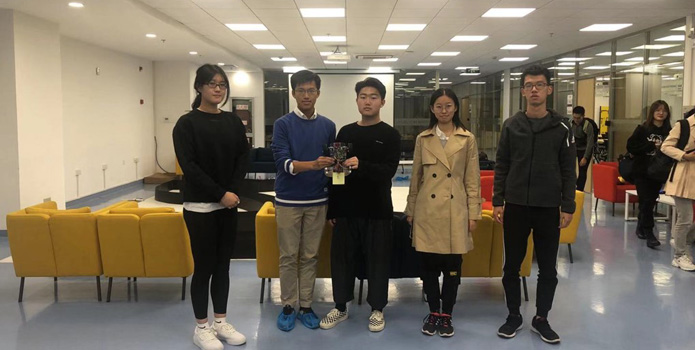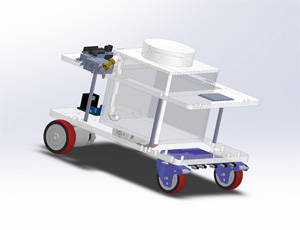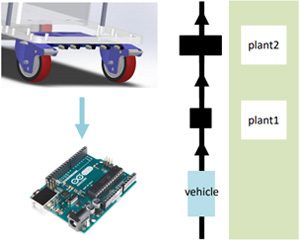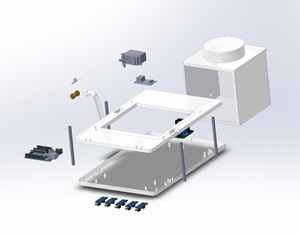
Student Projects
VG100

Automatic Vehicle for Irrigation
Instructors: Dr. Mian Li, Dr. Irene Wei
Team Members: Chenxi Lin, Hanlin Gao, Pauline Wang, Xueru Jiang, Zimu Gong
Project Video
Team Members

Team Members:
Chenxi Lin, Hanlin Gao, Pauline Wang, Xueru Jiang, Zimu Gong
Instructors:
Dr. Mian Li, Dr. Irene Wei
Project Description
Problem
Greens are crucial for people’s lives. However, watering them may require great effort, time and cost, whether in parks or private gardens. It is heavy labor for human, gardeners may have to work under hot summer sun. Moreover, fixed spraying system are expensive, difficult to fit or alter.
Concept Generation
Our project aims at building a prototype of automatic vehicle for irrigation, which moves along the designated route, and waters the plants around. Thus, manual labor and cost could be saved for this job.
Design Description
The vehicle has two parts, a movable chasis and a watering system. The chasis contains 2 dc motors powering back wheels, while 2 universal wheels in the front deals with turning. Also, the five infrared sensors in the front keeps the vehicle on the designated track. The watering part consists of a pump, a tank and a spreading head. The pump is controlled by a relay, and the angle is adjusted by a servo. When the vehicle arrives at a plant, it will stop and water the plant.

Fig. 1 The structure of the vehicle

Fig. 2 Working thesis of the vehicle
Modeling and Analysis
Our project is mainly divided into three parts. Firstly, we set lines on the ground for the vehicle to follow. The infrared sensors would scan whether the vehicle is on the track, and adjust the turning angle to keep itself on the track, so it could run automatically.
Secondly, the marked points on the track, which are different in width would tell the vehicle information of watering amount and angle. The vehicle would stop at these points.
Thirdly, the servo would adjust the angle of the spray head according to the type of plant. Then, the relay would control the water pump to spray the certain amount of water.
Secondly, the marked points on the track, which are different in width would tell the vehicle information of watering amount and angle. The vehicle would stop at these points.
Thirdly, the servo would adjust the angle of the spray head according to the type of plant. Then, the relay would control the water pump to spray the certain amount of water.

Fig. 3 The system design
Validation
First we test whether the car is able to follow the line on the ground and spray the right amount of water corresponding to the information on the marked points. Next, we examine whether the watering is sufficient by scrutinizing the droplets on the leaves visually. Additionally, we test different kinds of plants and accordingly changed the water amount. Finally, to test its feasibility more accurately and make further optimization, we did a trial by comparing the expected soil humidity with the humidity test by our sensor.
Conclusion
By building this automatic vehicle for irrigation, we provide a convenient solution to plant watering problem. The vehicle could be applied to water the parks and private gardens automatically. It would lessen the workload of workers, and has great compatibility as it is easy to apply. Also, the cost could be reduced. For further improvements, it is possible to add an automatic water supply system, which refills the tank every time the vehicle returns to the base, thus making the watering system more intelligent.
Acknowledgement
Dr. Mian Li and Dr. Irene Wei from the UM-SJTU Joint Institute;
Teaching Assistants [Feng Hanyang, Qi Fubo, Qiao Sheng, Wang Xiaoxuan] for VG100 at UM-SJTU Joint Institute.
Teaching Assistants [Feng Hanyang, Qi Fubo, Qiao Sheng, Wang Xiaoxuan] for VG100 at UM-SJTU Joint Institute.
More project information, please contact: [pauline-wang@sjtu.edu.cn zimmergong@sjtu.edu.cn]
UM-SJTU JOINT INSTITUTE